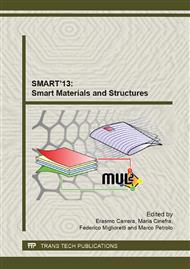[1]
P. Gaudenzi, Smart Structures: Physical Behaviour, Mathematical Modelling and Applications, John Wiley & Sons, 2009.
Google Scholar
[2]
H. Sonh, C.R. Farrar, F.M. Hemez, D. D. Shunk, D.W. Stinemates, B.R. Nadler, J.J. Czarnecki, A Review Of Structural Health Monitoring Literature:1996-2001, Los Alamos National Laboratory, 2003.
Google Scholar
[3]
K.H., Hsieh, M.W. Halling, P.J. Barr, Overview Of Vibrational Structural Health Monitoring With Representative Case Studies, Journal Of Bridge Engineering (2006).
DOI: 10.1061/(asce)1084-0702(2006)11:6(707)
Google Scholar
[4]
P.C. Chang, A. Flatau, S.C. Liu, Review Paper: Health Monitoring Of Civil Infrastructure, Structural Health Monitoring (2003).
DOI: 10.1177/1475921703036169
Google Scholar
[5]
L.F. Ramos, R. Aguilar, P.B. Lourenco, Operational Modal Analysis Of Historical Constructions Using Commercial Wireless Platforms, Structural Health Monitoring 10 (2011) 511.
DOI: 10.1177/1475921710388973
Google Scholar
[6]
T. Watteyne, K.S.J. Pister, Smarter cities through standards-based wireless sensor networks, IBM Journal of Research and Development 55 (2011).
DOI: 10.1147/jrd.2010.2092257
Google Scholar
[7]
S. Yuan, X. Lai, X. Zhao, X. Xu, L. Zhang, Distributed structural health monitoring system based on smart wireless sensor and multi-agent technology, Smart Materials and Structures, 15 (2006) 1-8.
DOI: 10.1088/0964-1726/15/1/029
Google Scholar
[8]
J. Wu, S. Yuan, S. Ji, G. Zhou,Y. Wang, Z. Wang, Multi-agent system design and evaluation for collaborative wireless sensor network in large structure health monitoring, Expert Systems with Applications 37 (2010) 2028-2036.
DOI: 10.1016/j.eswa.2009.06.098
Google Scholar
[9]
S. Ganerival, R. Kumar, M.B. Srivastava, Timing-sync Protocol for Sensor Networks, SenSys'03: Proceedings of the First International Conference on Embedded Networked Sensor Systems (2003) 138-149.
DOI: 10.1145/958491.958508
Google Scholar
[10]
F. Sivrikaya, B. Yener, Time synchronization in sensor networks: A survey, IEEE Network 18 (2004) 45-50.
DOI: 10.1109/mnet.2004.1316761
Google Scholar
[11]
N. Xu, S. Rangwala, K.K. Chintalapudi, D. Ganesan, A. Broad, R. Govindan, D. Estrin, A wireless sensor network for structural monitoring, SenSys'04 - Proceedings of the Second International Conference on Embedded Networked Sensor Systems (2004) 13-24.
DOI: 10.1145/1031495.1031498
Google Scholar
[12]
J. He, P. Cheng, L. Shi, J. Chen, Time synchronization in WSNs: A maximum value based consensus approach, Proceedings of the IEEE Conference on Decision and Control (2011) 7882-7887.
DOI: 10.1109/cdc.2011.6161443
Google Scholar
[13]
A. Rytter, Vibrational based inspection of civil engineering structures PhD thesis, Department of Building Technology and Structural Engineering, Aalborg University, Denmark, 1993.
Google Scholar
[14]
R. Barboni, A. Mannini, E. Fantini, P. Gaudenzi, Optimal Placement of PZT actuators for the control of beam dynamics, Smart Materials and Structures 9 (2000) 110-120.
DOI: 10.1088/0964-1726/9/1/312
Google Scholar
[15]
H. Fukunaga, N. Hu, F.-K. Chang, Structural damage identification using piezoelectric sensors, International Journal of Solids and Structures 39(2001) 393-418.
DOI: 10.1016/s0020-7683(01)00149-4
Google Scholar
[16]
N.M.M. Maia, R.A.B. Almeida, A.P.V. Urgueira, R.P.C. Sampaio, Damage detection and quantification using transmissibility, Mechanical Systems and Signal Processing 25 (2011) 2475-2483.
DOI: 10.1016/j.ymssp.2011.04.002
Google Scholar
[17]
R.P.C. Sampaio, N.M.M. Maia, Strategies for an efficient indicator of structural damage, Mechanical Systems and Signal Processing 23 (2009) 1855-1869.
DOI: 10.1016/j.ymssp.2008.07.015
Google Scholar
[18]
K. Worden, C.R. Farrar, G. Manson, G. Park, The fundamental axioms of structural health monitoring, Proceedings of the Royal Society A: Mathematical, Physical and Engineering Sciences 463 (2007) 1639-1664.
DOI: 10.1098/rspa.2007.1834
Google Scholar
[19]
C.R. Farrar, K. Worden, An introduction to structural health monitoring, Philosophical Transactions of the Royal Society A: Mathematical, Physical and Engineering Sciences ,365 (2007) 303-315.
DOI: 10.1098/rsta.2006.1928
Google Scholar
[20]
D. Montalvao, N.M.M. Maia, A.M.R. Ribeiro, A review of vibration-based structural health monitoring with special emphasis on composite materials, Shock and Vibration Digest 38 (2006) 295-324.
DOI: 10.1177/0583102406065898
Google Scholar


